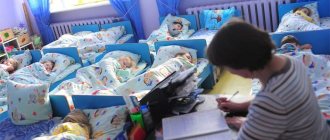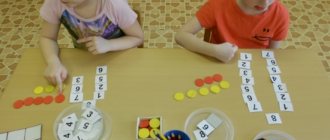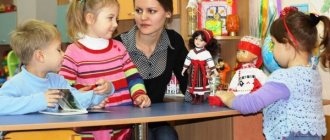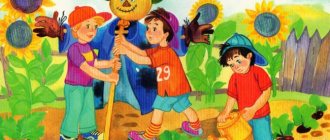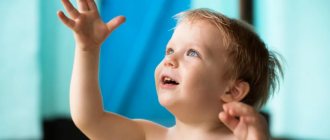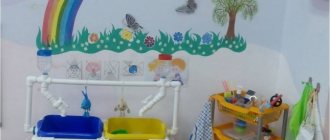Components of the regime
To begin with, it’s worth identifying all the important components of the daily routine of two-year-old children:
- Nutrition. At two years old, the number of meals is 4 or 5. If parents eat a healthy and balanced diet, then their son or daughter can be transferred to a common table. But you need to offer dishes that correspond to the age characteristics of the baby.
- Dream. Rest is extremely important, as it allows you to restore strength, absorb and process the information received, and “reboot” the nervous system.
- Development: emotional, physical and intellectual. This component includes active games and gymnastics, various developmental activities, creativity, communication with family members and peers.
- Walks. Fresh air is also essential for well-being and good health.
If you don't follow a daily routine
If parents are illogical in observing the children’s daily routine, then they force the child to follow it, then they let everything take its course, this negatively affects the baby’s nervous system. He may have the following health problems.
- Moodiness, irritability, nervousness
- Fast fatiguability
- Changes in activity and rest
- Mood swings
- Lack of sleep, poor sleep
- Poor appetite
- Insufficient assimilation of information
- Reluctance to clean up after yourself or help your mother
Mode of a child not attending kindergarten
If the child is still sitting at home and does not attend a general education preschool institution, then his regime may be something like this:
| Time intervals | Actions |
| From 7:30 to 8.00 | Waking up, changing clothes, hygiene procedures (washing and brushing teeth) |
| From 8.00 to 8:15 | Morning exercises |
| From 8:15 to 8:30 | Breakfast |
| From 8:30 to 9.00 | Preparing for the walk |
| From 9.00 to 10:30 | Morning walk |
| From 10:30 to 12.00 | Leisure at home: games, activities, creativity |
| From 12.00 to 12:30 | Dinner |
| From 12:30 to 13.00 | Preparing for the day's rest |
| From 13.00 to 15.00 | Dream |
| From 15.00 to 16.00 | Waking up, changing clothes, quiet games, communicating with family members, preparing for afternoon snack |
| From 16.00 to 16:30 | Afternoon snack |
| From 16:30 to 18:00 | Walk |
| From 18.00 to 18:30 | Games, activities |
| From 18:30 to 19.00 | Dinner |
| From 19.00 to 20.00 | Quiet entertainment at home, communication with family |
| From 20.00 to 20:30-20:40 | Getting ready for bed: light snack if desired (a glass of kefir or milk), hygiene procedures (bathing and brushing teeth), putting on pajamas |
| From 20:30-20:40 to 21:00 | Setting the mood for sleep: reading a fairy tale or singing a lullaby, calm conversations, stroking the head |
| From 21.00 to 6.00-7.00 | A good night's sleep |
The daily schedule presented above is approximate. It is necessary to create and organize a regimen taking into account the individual needs and characteristics of each specific child. So, if the baby wakes up later or earlier, then awakening and, accordingly, going to bed at night may shift. Still, you should adhere to the recommended intervals between activities so that the periods of wakefulness and rest are not too short or, on the contrary, long.
Daytime nap
As the child begins to focus on open communication and acquires new skills, he needs a rational daily routine. If your baby goes to kindergarten, maintain the routine of this preschool institution - it will be easier. In order for a three-year-old child to be productive and healthy, a nap must be included in his daily routine, which can be reduced by an hour at the age of three (the baby’s nap should last at least two hours).
The routine of a child attending kindergarten
If a child already goes to kindergarten at two years old, then his routine should be adapted to attending a preschool educational institution. The regime in preschool educational institutions complies with generally accepted educational federal state standards (FSES), and it must be communicated to parents in an accessible form. You can find information at the information stand in the kindergarten or on its official website.
Below is a table by the hour, which describes the daily routine for children in kindergarten:
| Time | Actions |
| 6.00-7.00 | Getting up, hygiene procedures, preparing for going to kindergarten (dressing, getting ready) |
| From 7.00 to 8.00 | Reception of children in kindergarten, examination by a doctor, gymnastics and games |
| From 8.00 to 8:30 | Preparing for meals and breakfast |
| From 8:30 to 9.00 | Group classes |
| From 9.00 to 9:10-9:15 | Second light breakfast in the form of a small snack |
| From 9:15 to 9:30 | Preparing children for a walk: dressing, collecting toys for playing outside |
| From 9:30 to 11-11:30 | Walk around the facility in the fresh air under the supervision of teachers |
| From 11-11:30 to 12.00 | Free children's activities |
| From 12.00 to 13.00 | Preparing for meals and lunch |
| From 13.00 to 15.00 | Preparing for daytime rest, sleep |
| From 15.00 to 15:30 | Awakening and subsequent water procedures |
| From 15:30 to 16:00 | Afternoon snack |
| From 16.00 to 16:30 | Group activities and games |
| From 16:30 to 17:40 | Second walk |
| From 17:40 until approximately 18:15-18:20 | Preparing for meals and dinner |
| From 18:20 to 19.00 | Going home |
| From 19.00 to 20.00 | Quiet entertainment at home, communication with family |
| From 20.00 to 20:30-20:40 | Getting ready for bed: light snack if desired (a glass of kefir or milk), hygiene procedures (bathing and brushing teeth), putting on pajamas |
| From 20:30-20:40 to 21:00 | Setting the mood for sleep: reading a fairy tale or singing a lullaby, calm conversations, stroking the head |
| From 21.00 to 6.00-7.00 | A good night's sleep |
In bad weather, walks are replaced by group activities, such as creativity or different activities.
Important! At home on weekends you should follow approximately the same regime that applies in kindergartens. Of course, it is quite possible to allow your baby to sleep an extra hour in the morning and go to bed a little later in the evening. But you should not neglect the regime on weekends, holidays and periods of illness: having relaxed, the child will have difficulty adjusting back to the previous kindergarten regime.
Activity of a child 1-1.5 years old throughout the day
As we have already figured out, the baby sleeps for about 4-4.5 hours during the day. The same amount of time is spent on the period of activity. Changing the daily routine, that is, reducing the period of sleep or period of activity, should not be done, because this may have an undesirable effect on the child’s health. The child may suffer from increased fatigue or, conversely, lethargy.
To make the child’s activity more varied throughout the day, it is necessary to include bathing and educational games in the daily routine. Books, bright toys, pyramids, cubes are a very good way to diversify the waking period of a child aged 1-1.5 years.
Features of sleep of a two-year-old child
A two-year-old child should sleep about 13 hours a day. Approximately 10-11 hours are spent on night rest, and during the day the baby sleeps for about 2.5-3 hours, once. At two years old, another transition period may begin, along with which some sleep problems will come. The baby actively learns everything, develops and has fun, so he can go on vacation with whims, indignation and reluctance. Some psychologists call this behavior a false refusal to sleep.
A false refusal to rest may be a feature of emotional development, but sometimes it is provoked by the influence of certain factors, such as the absence or non-compliance with the daily routine, overwork or, conversely, the lack of activity and the possibility of an outburst of energy, overeating and abuse of sweets, an excited state or quarrels between parents, watching TV or games with smartphones and tablets.
Important! Be sure to observe your child’s behavior, because it indicates the need for rest. If the baby is lethargic, capricious, drowsy, irritable and yawns, it’s time for him to rest. But sometimes the decline in activity is preceded by a period of excitement, when the baby jumps, runs, screams and plays pranks. And such a surge of energy will likely be followed by an urgent need for a break, expressed in apathy, whims and yawning.
To improve night and daytime sleep, you should follow a few simple rules:
- Compliance with certain rituals - a sequence of actions preceding bedtime. This could be hygiene procedures, changing into pajamas, reading a fairy tale or singing a lullaby, dimming the lights, stroking the baby on the head. The ritual gives a feeling of calm and suggests that sleep will follow.
- Favorable atmosphere in the bedroom: temperature about 20-22 degrees, ventilated room, absence of loud sounds and noises, dim light.
- A walk before bed is advisable. It saturates the body with oxygen and relaxes.
- A burst of energy during the waking period. If the baby is tired enough (but not overtired!), then he will probably want to rest and quickly fall asleep.
- Preparing for bed in advance. Laying should not be done suddenly and abruptly. It is advisable to reduce activity half an hour to an hour before falling asleep and switch to quiet activities, eliminating all external stimuli (bright sunlight, sounds).
- Increasing the time interval between eating and sleeping. If the baby has just eaten a heavy meal, he will not be able to fall asleep quickly and soundly. You need to wait 30-60 minutes so that the food has time to partially digest.
The best daily routine
It will be considered optimal if the child’s daily schedule is designed in such a way that it coincides with his natural needs. If the child sleeps during the day at 13.00, then it is best to plan naps during the day at this time. If you suddenly change a child’s habits, his nervous system will suffer, and this daily routine will not bring any benefit. Therefore, the daily routine for a child aged 1-1.5 years should be as gentle as possible. Parents can judge the success of their regime by the child's good mood and good health.
The best daily routine is the one that accustoms the child to order and organizes his leisure time. Then it will be much easier for the child to get used to kindergarten and school.
Nutrition
A two-year-old eats at least 4 times a day, but if desired, you can add an additional meal, for example, in the form of a second light breakfast-snack between the main breakfast and lunch.
The diet should include the following products in certain quantities:
- wheat bread – 60-70 g
- rye bread – 30 g
- pasta or cereals (dry) – 40 g
- meat – 60-70 g
- fish – 60-70 g
- potatoes – up to 100-150 g
- other various vegetables – 150 g
- cottage cheese – up to 80-100 g
- milk – 200 g
- yogurt or kefir – 200 g
- cottage cheese – up to 100 g
- butter - a tablespoon;
- vegetable oil - a tablespoon;
- sour cream - a teaspoon;
- eggs – a whole small egg;
- dried fruits – 10-15 g
- hard cheese with a fat content of 45% - a five-gram piece.
Let's look at a sample menu for one day in the table:
| Eating | Dishes (examples) |
| Breakfast | 60 g steamed omelette, 150 g porridge cooked in milk, 150 ml tea or juice |
| Dinner | 100 ml of vegetable soup, steamed cutlet (60 g), 50 g of vermicelli, 50 g of seasonal vegetables (in the form of a salad dressed with sour cream or butter), 150 ml of compote (for example, from dried fruits) |
| Afternoon snack | 100 grams of yogurt or kefir, 50 g of cookies or rolls, fruit (apple, pear, peaches) |
| Dinner | 100 g mashed potatoes with butter, 100 g vegetable stew, 50 g fish (soufflé, cutlet) |
There is no longer a need for breastfeeding at two years old, but the mother can breastfeed if the baby needs it.
Bathing and hardening
Before afternoon tea you need to give your child a bath. If not bathing, then rubbing, it is also very useful for hardening. First they wipe the child's arms, then the chest, then the legs, then the back. The water temperature should be no higher than 35 degrees Celsius. To harden a baby under the age of one and a half years, you can gradually reduce the water temperature. Once a week or five days, when bathing and drying, reduce the water temperature by 5 degrees, resulting in a water temperature of 24 degrees. You should not give up hardening - it greatly strengthens the child’s nervous, immune and respiratory systems.
Games
At two years old, the following games and entertainment will be useful and interesting for the baby:
- role-playing games, including with dolls, sets for different professions;
- games with interactive toys;
- puzzles, sorters, busy boards,
- cubes, pyramids, construction sets with large parts;
- dancing, performing movements to music;
- hide and seek;
- singing.
Classes
Activities with a two-year-old child may include:
- drawing with pencils or paints;
- modeling from salt dough or plasticine;
- Reading books;
- simple crafts, such as appliqués;
- cards with different objects or animals;
- sorting cereals and putting them into different containers;
- learning new words with an explanation of their meaning;
- getting help around the house.
Development and education
At two years old, a child can do a lot: pronounce from 50 to 300 words, try to speak in short sentences, fulfill requests, express emotions, play without the participation of adults, ask to go to the potty (not always), eat food independently, dress or try to do this, repeat the movements and actions of adults, show and defend their desires, be actively interested in the world around them and communicate with peers, go down and up stairs, draw “doodles” and lines, dance and sing primitively (repeat the rhythm), try to disassemble and assemble objects, wipe hands and try to brush your teeth, actively participate in different games, and perform sequential complex actions.
Parenting includes the active involvement of the child in familiar everyday processes: dressing, hygiene procedures, preparing for meals, cleaning, and so on. Parents must also set boundaries and boundaries of what is permitted, stopping the child in case of incorrect or prohibited actions. Communication is very important, including discussing everything that is happening.
Age characteristics of a child 1-1.5 years old
When a child turns one year old, he begins to develop more rapidly than before. And at the same time, a child at this age still has many inconsistencies. Physically, the child is not yet able to withstand the whole day without sleep; he gets tired quickly. At the same time, the child loves to run and jump a lot and actively, however, he gets tired very soon and needs rest. The child’s coordination of movements is still insufficient, despite the fact that he wants to play for a long time and a lot.
A child at this age can fulfill an adult’s request to bring or serve something, and his active vocabulary begins to quickly expand. A child at this age throws away the pacifier and begins to eat with a spoon. True, it sheds a lot at the same time.
Physical activity
The physical development of a two-year-old is an important component of the regime. The baby is actively moving, but his coordination is not quite perfect yet. And this is important to consider when practicing games or any exercises. To develop dexterity, coordination and endurance, you can offer your child the following games and exercises:
- walking in place or in a straight line;
- jumping in place;
- squats, bends in different directions, back and forth;
- ball games;
- exercise “bicycle” in a lying position;
- dancing to rhythmic music;
- moving “in single file” (squatting);
- lifting objects from the floor;
- hanging on gymnastic rings.
Gymnastics should definitely be done in the morning. Also, physical activity at home is desirable if walking in the fresh air is not yet possible for some reason.
Walks
During walks, a two-year-old child must explore the world around him, contact and communicate with peers, recognize natural phenomena, examine objects and analyze the actions of other people, and also be sure to be physically active.
Important! Dress your baby according to the weather so that he does not freeze or sweat. Cancel walks when sick or in bad weather.
A competently and clearly organized daily routine for a two-year-old child will ensure the comfort of the whole family and help them learn discipline. And parents will be able to free up time for personal matters.
